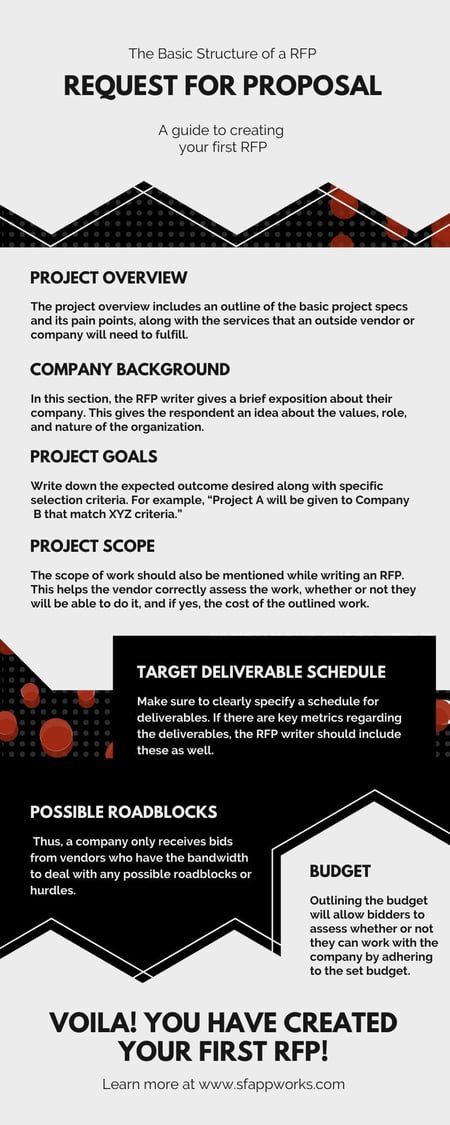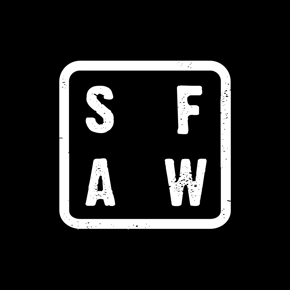If you work in technology then you probably have come across or had to put together a Request for Proposal. In the digital world, A Request for Proposal, or an RFP, is sent out by a business to a potential software/tech agency or company to request a plan and budget for the development of an application. After the potential agency sends back the RFP, the business decides whether or not that company is a good fit, and if they should proceed to work with them.
What Does “Request For Proposal” Mean?
Businesses draft an RFP when they need to outsource services, like technological or software needs, to an outside vendor or company. The RFP consists of project details to help bidders understand the requirements. Businesses send the RFP to many vendors in order to secure the right vendor for the project.
Related: 10 Powerful Benefits of Programming Outsourcing
Why Do Businesses Write RFPs?
The main objective of writing an RFP is to streamline the selection process. An RFP helps narrow the list of potential vendors for the project. This makes the process significantly easier than spending time evaluating vendors who have no idea what the project entails. A business drafts an RFP when they have a particular set of requirements that need to be outsourced.
An RFP helps a business acquire bids and proposals in order to make an informed decision about which agency or company to use. For this reason, a well-drafted RFP is crucial to ensure that the selection process is smooth and easy.
How to Write a Request for Proposal
A Request For Proposal follows a basic structure that hits all the necessary points required for a business to analyze the potential of a bidding agency or company in the context of the project.
RFP Template
- Project Name or Description:
- Company Name:
- Address: City, State, Zip Code(PCP):
- Procurement Contact Person :
- Telephone Number of PCP
- Email Address of PCP
- Fax Number
1. Project Overview
The project overview includes an outline of the basic project specs and its pain points, along with the services that an outside vendor or company will need to fulfill. A brief overview is sufficient, as the business will relay further project details and sensitive information to the vendor once they have selected one.
2. Company Background
In this section, the RFP writer gives a brief exposition about their company. This gives the respondent an idea about the values, role, and nature of the organization and helps them understand the goal better.
3. Project Goals
The aim of this section is to outline the goals of the project. Here, it’s essential to be as specific as possible. Write down the expected outcome desired along with specific selection criteria. For example, “Project A will be given to Company B that match XYZ criteria.”
4. Project Scope
Along with the goals, the scope of work should also be mentioned while writing an RFP. This helps the vendor correctly assess the work, whether or not they will be able to do it, and if yes, the cost of the outlined work.
5. Target Deliverable Schedule
In an RFP, the business should clearly specify a schedule for deliverables. If there are key metrics regarding the deliverables, the RFP writer should include these as well. This helps vendors assess their availability during the specified schedule.
6. Possible Roadblocks
Outlining roadblocks that may arise during the duration of the projects help eliminate bidders who aren’t comfortable with them. Thus, a company only receives bids from vendors who have the bandwidth to deal with any possible roadblocks or hurdles.
7. Budget
Outlining the budget will allow bidders to assess whether or not they can work with the company by adhering to the set budget.
If this sounds confusing, don’t worry, there’s a sample below that will help you out.

RFP Sample
Download our Request For Proposal Template or use the sample guidelines below to create your own document.
Sample Guidelines for Writing a Request for Proposal
With the help of this Request For Proposal Sample, it’ll be easy to recreate it and use it as a framework while drafting an RFP as and when needed.
Project Name or Description: Website Development and App Development
- Company Name: Dave’s Online Store
- Address: 22nd St Avenue
- City, State, Zip Code: New York, New York, 10004
- Procurement Contact Person (PCP): Dave Smith
- Telephone Number of PCP: 234-908-1234
- Email Address of PCP: dave@dnc.com
- Fax Number: N/A
- Project Overview
Dave’s Online Store, an eCommerce store, is looking for an agency to help with their website needs. The website needs to be tweaked and optimized and an app has to be developed for the eCommerce store.
- Company Background
Dave’s Online Store is an eCommerce store headquartered in Manhattan, NewYork. We have been selling toys online for over 5 years in the United States. We specialize in plush toys and are now moving into technology-enabled toys for kids aged 5-14.
- Project Goals and Scope Of Services
Dave’s Online Store is seeking a web development and app development agency that can provide us with a revamped version of our pre-existing website and also develop an iOS-based application for our eCommerce store. The project will be given to the company with excellent design skills and a proven track record of successful e-commerce websites.
The selected firm will be responsible for website and application content updates and maintenance. Tasks include but aren’t limited to:
- Project Management
- Copywriting
- Content Strategy
- Search Engine Optimization
- Visual Design
- App Development
- Front-End Coding
- Back-End Coding
- Testing
- Mobile Device Optimization
- Software Training
- Selection Schedule
The RFP timetable is listed below:
Request For RFP: November 1st, 2019.
Submission Deadline: December 3rd, 2019.
Dave’s Online Store Response Deadline: December 20th, 2019.
Selection Of Top Bidders/Notification To Unsuccessful Bidders: January 3rd, 2020.
Start Of Negotiation: January 10th, 2020.
Contract Award/Notification To Unsuccessful Bidders: January 30th, 2020.
- Time and Place Of Submission Of Proposals
The RFP will be available to download on davesonlinestore.com from 1st November 2019. The bidder has to submit one original and 2 copies of the proposal and email it to the PCP email address with the subject: RFP-Website Development and App Development_[Company Name].
Entries that miss the deadline or fail to follow the submission guidelines will not be considered.
- Timeline
The project should be completed within 9 months.
- Elements Of Proposal
A submission must include the following elements. These are the minimum prerequisites that have to be mentioned in the proposal.
- Description of the company, names, and titles of the development team and the total number of full-time employees.
- A letter stating the strengths of the company which seems relevant to the project’s objectives.
- A portfolio of work done for past and current clients will help us assess your work.
- Evaluation Criteria
A successful bidder will be,
- A web/app development agency that has been operational for a period of 36 months and is capable of both web and app development along with visual and creative strategy implementation.
- A company that has experience with developing and maintaining an eCommerce store.
- A company that provides a competitive cost of services.
- A company that consists of a highly skilled and educated team that can handle tasks with minimum supervision.
Related: How to Hire a Mobile App Developer
- Possible Roadblocks
Bidders should be aware that due to the nature of the eCommerce store, catalogs are constantly changing and may require a dedicated person/team to handle immediate requests with fast turnaround times.
- Budget
Dave’s Online Store’s budget for this project is $20,000.
In Conclusion
These are the central elements that a business should include in an RFP. A company has to decide what elements they should add to an RFP based on their specific requirements and outsourcing needs. This is merely a template and a framework for companies to use.
The next step for a business is to sit with their teams and understand the project’s goals, the scope of work and the objective in order to start drafting the RFP. After deciding on the necessary information, all that’s left to do is to draft it up (perhaps using our template!) and wait for the submissions to roll in and the project to take off. For advice about technology platforms available, consult with our specialists at SF AppWorks.




COMMENTS